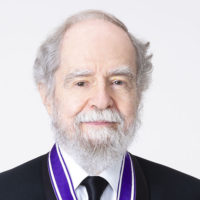
2019 Kyoto Prize Laureates
Earth and Planetary Sciences, Astronomy and Astrophysics
/ Astrophysicist
1938 -
Emeritus Eugene Higgins Professor of Astrophysical Sciences, Princeton University
Understanding the Universe and the Things That Live in It Through Astronomical Surveys
2019
11 /11 Mon
13:00 - 16:00
Place:Kyoto International Conference Center
Capacity:1,500 persons (FCFS)
Admission Free
Wide-Field Sky Survey of the Universe: from the Past to the Future of Astronomy
2019
11 /13 Wed
10:00 - 17:00
Place:Tetsumon Memorial Auditorium, Faculty of Medicine Experimental Research Bldg. The University of Tokyo
Capacity:250 persons (FCFS)
Admission Free
Dr. Gunn led the Sloan Digital Sky Survey, which produced a three-dimensional digital cosmic map encompassing a broad region. He played a leading role in the project, including planning, instrument development, and data analysis, and contributed to the elucidation of the evolutionary history of the universe. He also published many pioneering astrophysical theories. Through these achievements, he has provided us a significant understanding of the universe.
Dr. James Gunn conceived and designed the Sloan Digital Sky Survey (SDSS) project (1), which produced a three-dimensional digital cosmic map. He realized the project successfully by developing the necessary innovative technologies for the observations and data analysis. On the basis of the enormous amount of precise data produced by the SDSS, Dr. Gunn made outstanding contributions to the elucidation of cosmic history and the properties of various celestial objects and to determining the parameters of the expanding universe with unprecedented accuracy.
Dr. Gunn led the design of the key hardware components of the SDSS, a 2.5-m wide-field telescope (2), an ultra-large mosaic CCD camera (3), and a multi-object spectrograph that acquires spectra of 640 celestial objects simultaneously (4). This project commenced in 1992 with seven U.S. institutions and a Japanese group, and regular observations began in April, 2000. As the data and research results were published, the number of participating institutions increased to 25. By 2009, 230 million celestial objects were cataloged, and the spectra of 930,000 galaxies, 120,000 quasars, and 460,000 stars were obtained (5). Through the publication of the SDSS astronomical catalog, containing an overwhelming amount of homogeneous information, numerous discoveries were made by many astronomers at institutions all over the world. Thus, the SDSS is now regarded as one of the most successful projects in the history of observational astronomy.
The three-dimensional cosmic map of galaxies made from the SDSS contributed to the elucidation of the evolutionary history of the large-scale structure of the universe (6, 7). The SDSS data also led to the discoveries of numerous distant quasars (8), gravitational lenses (9), and new populations of low-temperature brown dwarf star (10). The data on the large-scale galaxy distribution obtained by the SDSS were combined with the data on the temperature fl uctuation in the cosmic microwave background radiation to reveal that the fraction of normal matter in the universe is less than 5%, whereas the rest of the universe is composed of dark matter (25%) and dark energy (70%) (11). Today, this fi nding has been established as the standard model of the universe.
Dr. Gunn not only led the SDSS, but earlier in his career also published an important idea that determines the degree of ionization of the early universe (12) as well as many other pioneering astrophysical theories (13). He has also made major contributions to the development of many other innovative astronomical instruments. As modern astronomical research has progressively become more specialized, Dr. Gunn is a rare astronomer who has produced outstanding achievements in theory, observation, and instrument development.
For these reasons, the Inamori Foundation is pleased to present the 2019 Kyoto Prize in Basic Sciences to Dr. James Gunn.
References
(1) York DG et al. (2000) The Sloan Digital Sky Survey: technical summary. The Astronomical Journal 120: 1579‒1587.
(2) Gunn JE et al. (1998) The 2.5 m telescope of the Sloan Digital Sky Survey. The Astronomical Journal 131: 2332‒2359.
(3) Gunn JE et al. (1998) The Sloan Digital Sky Survey photometric camera. The Astronomical Journal 116: 3040‒3081.
(4) Smee SA et al. (2013) The multi-object, fi ber-fed, spectrographs for the Sloan Digital Sky Survey and the baryon oscillation spectroscopic survey. The Astronomical Journal 146: 32.
(5) Abazajian KN et al. (2009) The seventh data release of the Sloan Digital Sky Survey. The Astrophysical Journal Supplement Series 182: 543‒558.
(6) Eisenstein DJ et al. (2005) Detection of the baryon acoustic peak in the large-scale correlation function of SDSS luminous red galaxies. The Astrophysical Journal 633: 560‒574.
(7) Becker RH et al. (2001) Evidence for reionization at z~6: detection of a Gunn-Peterson trough in a z=6.28 quasar. The Astronomical Journal 122: 2850‒2857.
(8) Fan X et al. (2001) High-redshift quasars found in Sloan Digital Sky Survey commissioning data. IV. Luminosity function from the fall equatorial stripe sample. The Astronomical Journal 121: 54‒65.
(9) Oguri M et al. (2006) The Sloan Digital Sky Survey quasar lens search. I. Candidate selection algorithm. The Astronomical Journal 132: 999‒1013.
(10) Hawley SL et al. (2002) Characterization of M, L, and T dwarfs in the Sloan Digital Sky Survey. The Astronomical Journal 123: 3409‒3427.
(11) Tegmark M et al. (2004) Cosmological parameters from SDSS and WMAP. Physical Review D 69: 103501.
(12) Gunn JE & Peterson BA (1965) On the density of neutral hydrogen in intergalactic space. The Astrophysical Journal 142: 1633‒1641.
(13) Ostriker JP & Gunn JE (1969) On the nature of pulsars. I. Theory. The Astrophysical Journal 157: 1395‒1418.
Profile is at the time of the award.